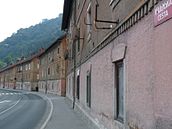Trbovlje
| Trbovlje | |
|---|---|
| Town | |
  
Left to right, from top: apartment block at Sallaumines Street,
Trbovlje Chimney, Miners' Houses |
|
| Location in Slovenia | |
| Coordinates: 46°09′N 15°03′E / 46.150°N 15.050°ECoordinates: 46°09′N 15°03′E / 46.150°N 15.050°E | |
| Country |
|
| Traditional region | Styria |
| Statistical region | Central Sava |
| Municipality | Trbovlje |
| Settled | 1220s |
| Incorporated | 1850 |
| Government | |
| • Mayor | Jasna Gabrič |
| Area | |
| • Total | 12.6 km2 (4.9 sq mi) |
| Elevation | 307 m (1,007 ft) |
| Population (2013) | |
| • Total | 14,842 |
| • Rank | 9th, Slovenia |
| • Density | 1,179/km2 (3,050/sq mi) |
| Time zone | CET (UTC+01:00) |
| • Summer (DST) | CEST (UTC+02:00) |
| Postal code | 1420 |
| Area code(s) | 03 (+386 3 from abroad) |
| Google Maps | Trbovlje, Slovenia |
| Climate | Cfb |
| Website | www |
Trbovlje (pronounced [təɾˈbɔ̀ːwljɛ];German: Trifail) is Slovenia's ninth largest town, and the seat of the Municipality of Trbovlje. It is located in the valley of a minor left bank tributary of the Sava River in the Central Sava Valley in central-eastern Slovenia.
Trbovlje was attested in written sources in 1220–30 as Trefeul (and as Trevůl and Trevol in 1265–67, Triuella in 1302, Trifeul in 1325, Triueal in 1330, and Triuel in 1424). The name is a feminine plural noun in standard Slovene, but in the local dialect it is declined as a neuter singular adjective. This indicates that the name is derived from *Trěbovľe selo (literally, 'Trěbo's village'), referring to an early inhabitant of the place. In the past the German name was Trifail.
Coal mining began at Beech Mountain (Slovene: Bukova gora, 547 meters or 1,795 feet) south of the town in 1804. The town was connected to the Austrian Southern Railway in 1849, which contributed to its further development. During the 19th century, a cement plant, mechanical separator, sawmill, and power plant were built in Trbovlje.
Poor social conditions in Trbovlje led to several strikes by mine workers, and the town became a center of the leftist movement and communist agitation. On June 1, 1924 there was a clash between workers and members of the Organization of Yugoslav Nationalists that resulted in several fatalities on both sides. In 1934, miners staged a sitdown strike at the mine.
During the Second World War, Trbovlje, along with the rest of Lower Styria, was annexed to the Third Reich. The coal mine and other industries of Trbovlje were especially important to the German authorities, and they initially lowered unemployment in the town and increased wages, increasing satisfaction with the new regime. However, the arrest and exile of Slovenes in August 1941 created disaffection. This and other repressive measures resulted in an estimated 90% of the population opposing the Germans by the summer of 1944.
...
Wikipedia

